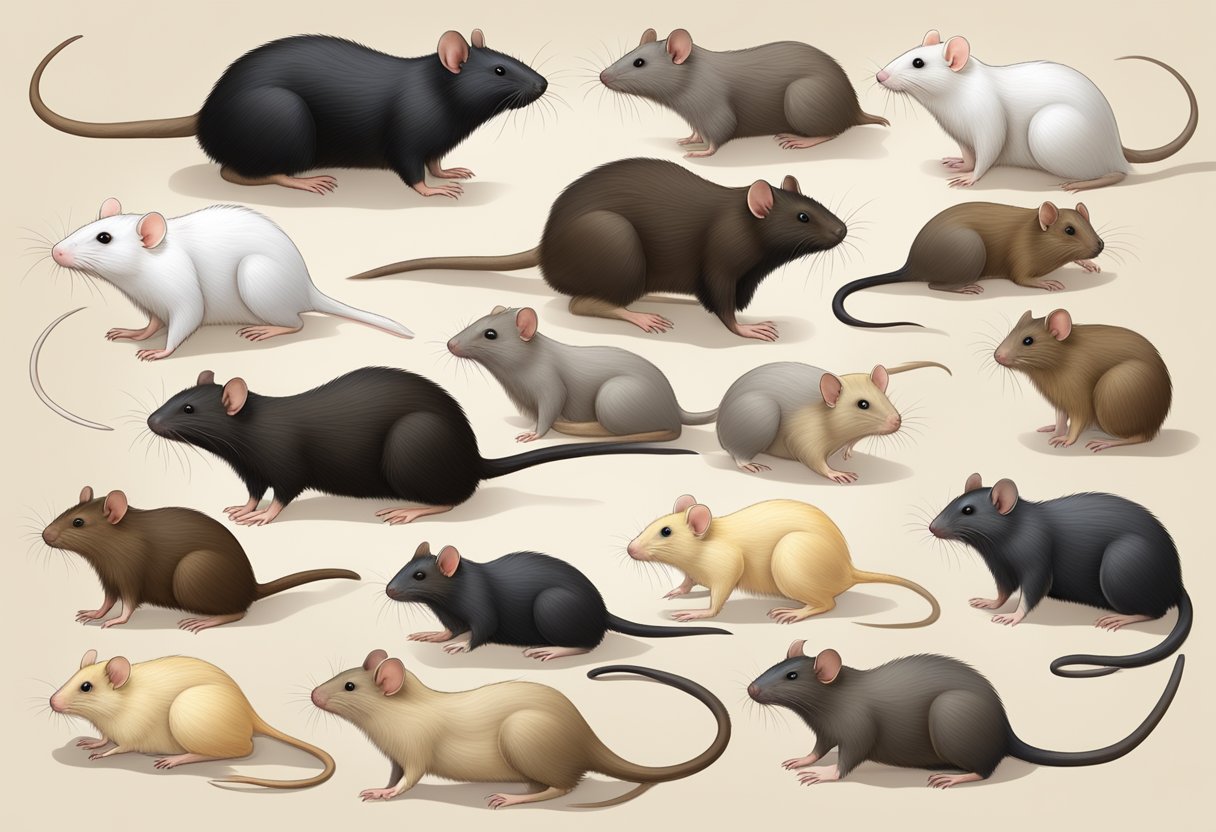Types Of Rats
Rats are a common sight in many urban and rural areas around the world. They belong to the order Rodentia, which includes mice, squirrels, and beavers. There are over 60 species of rats, and they can be found on every continent except for Antarctica. Rats are known for their sharp teeth, long tails, and quick movements, making them both fascinating and intimidating creatures.
Rat Classification and Species: Rats are classified into three groups: Old World rats, New World rats, and African rats. Old World rats are the most common and are found in Europe, Asia, and Africa. New World rats are found in North and South America, while African rats are found only in Africa. The most common species of rat is the brown rat, also known as the Norway rat. Other common species include the black rat and the roof rat.
Physical Characteristics: Rats are typically small to medium-sized mammals, with most species weighing between 100 and 500 grams. They have long, pointed noses, sharp teeth, and long, scaly tails. Rats are known for their adaptability and can thrive in a variety of environments, from sewers and garbage dumps to forests and fields.
Key Takeaways
- Rats are classified into three groups: Old World rats, New World rats, and African rats.
- Rats are typically small to medium-sized mammals, with most species weighing between 100 and 500 grams.
- Rats are known for their adaptability and can thrive in a variety of environments.
Rat Classification and Species

Rats are members of the Rattus genus, which includes over 60 species of rodents. These animals are found all over the world, with a few species being native to specific regions. The following are some of the common and lesser-known rat species.
Genus Rattus
The genus Rattus includes the common rats, which are the most well-known species of rats. The two most common species of rats are the black rat (Rattus rattus) and the brown rat (Rattus norvegicus). Other species in this genus include the Philippine forest rat, Sulawesi rat, bush rat, Himalayan field rat, Turkestan rat, and Sikkim rat.
Common Rat Species
The Norway rat (Rattus norvegicus), also known as the brown rat, is the most common type of rat found in urban areas. This rat species has brown fur on its back and gray fur underneath. Its tail is long and almost naked, and it has small ears.
The black rat (Rattus rattus) is the prototypical rat. It has a long tail, large ears, and a pointed snout. This species is found in many parts of the world, except for Antarctica.
The roof rat (Rattus rattus) is another common rat species that is found in urban areas. It has a long tail, large ears, and a pointed snout. This species is smaller than the Norway rat and has a sleeker body.
Lesser-Known Rat Species
The Philippine forest rat (Rattus everetti) is a species of rat that is found in the Philippines. It has a long tail and a brownish-gray coat.
The Sulawesi rat (Rattus hoffmanni) is a species of rat that is found on the island of Sulawesi in Indonesia. It has a long tail and a brownish-gray coat.
The bush rat (Rattus fuscipes) is a species of rat that is found in Australia. It has a long tail and a brownish-gray coat.
The Himalayan field rat (Rattus nitidus) is a species of rat that is found in the Himalayan region. It has a long tail and a brownish-gray coat.
The Turkestan rat (Rattus turkestanicus) is a species of rat that is found in Central Asia. It has a long tail and a brownish-gray coat.
The Sikkim rat (Rattus sikkimensis) is a species of rat that is found in the Himalayan region. It has a long tail and a brownish-gray coat.
In conclusion, rats are a diverse group of rodents that are found all over the world. The Rattus genus includes over 60 species of rats, with the common rats being the most well-known.
Physical Characteristics
Rats are small, agile, and intelligent mammals that belong to the Rodentia order. They have a distinct body shape that is characterized by a pointed snout, large ears, and a long, slender tail. In this section, we will discuss the physical characteristics of rats, including their size, appearance, coat, and color variations.
Size and Appearance
Rats are generally small animals that range in size from 5 to 11 inches in length, excluding their tails. They have a slender body shape that is covered in short, sleek fur. Adult male rats are typically larger than females, with a weight range of 16 to 23 ounces, while females weigh between 12 to 16 ounces.
Rats have a distinctive appearance that is characterized by their large, round eyes, and long, sharp whiskers. They also have a pair of fleshy pads on the soles of their narrow hind feet, which help them climb and grip surfaces.
Coat and Color Variations
Rats come in a variety of coat and color variations, including brown, black, and gray. Brown rats, also known as Norway rats, are the most common type of rat and are typically larger than other species. They have a brownish-gray coat that is coarse and shaggy.
Black rats, also known as roof rats, have a sleek black coat that is soft and velvety to the touch. They have a more slender body shape than brown rats and are excellent climbers.
Gray rats, also known as ship rats, have a grayish-brown coat that is smooth and glossy. They are similar in size to brown rats but have a more pointed snout and larger ears.
In conclusion, rats have a unique set of physical characteristics that make them well-suited for their environment. They are small, agile, and intelligent animals with a distinctive appearance that is characterized by their long tails, large eyes, and sharp whiskers. Their coat and color variations also make them a visually interesting species.
Behavior and Habitat
Rats are known for their adaptability and can thrive in a variety of habitats, including urban and rural areas. They are primarily nocturnal and are most active during the night. Rats are social animals and usually live in groups, which are called “mischief.”
Diet and Foraging Habits
Rats are omnivorous and will eat almost anything, including fruits, vegetables, grains, and meat. They are known to be opportunistic feeders, and their diet depends on the availability of food in their environment. Rats are excellent foragers and can travel long distances to find food. They have a keen sense of smell and can detect food from a distance.
Reproduction and Nesting
Rats are capable of reproducing quickly and can have several litters in a year. The gestation period for rats is about 21-23 days, and they can have up to 14 pups in a litter. Rats are known for their nesting behavior and will create their nests in a variety of locations, including burrows, trees, and buildings. They will use a variety of materials, including grass, leaves, and paper, to create their nests.
Habitat Preferences
Rats are found in a variety of habitats, including fields, forests, and coastal areas. They are also commonly found in urban areas, where they can find shelter and food. Rats prefer to live in areas that provide them with ample shelter, such as burrows or buildings. They are also known to climb trees and can make their nests in tree cavities.
In conclusion, rats are highly adaptable animals that can thrive in a variety of habitats. They are omnivorous and have a keen sense of smell, which helps them locate food. Rats are social animals and live in groups, and they are also known for their nesting behavior. They prefer to live in areas that provide them with ample shelter and food.
Rats and Human Interaction
Rats are a common sight in human-inhabited areas, and their relationship with humans can vary greatly depending on the context. This section will explore the different ways in which rats interact with humans and the implications of these interactions.
Rats as Pests and Disease Vectors
Rats are often considered pests due to their tendency to infest human structures and consume human food. They are also known to carry and transmit diseases such as typhus, hantavirus, and the bubonic plague. The spread of disease through rat populations has been a major concern throughout history, with the Black Death being one of the most devastating pandemics caused by rats.
Rats in Urban Environments
In urban environments, rats are often seen as a nuisance and a health hazard. They can damage buildings and infrastructure, contaminate food, and spread disease. Efforts to control rat populations in cities have included measures such as pest control programs, rat-proofing buildings, and improved sanitation practices.
Rats as Pets
Despite their reputation as pests, rats can also make excellent pets. Domesticated rats, also known as fancy rats, have been selectively bred for their docile nature and friendly disposition. They are intelligent animals with a keen sense of smell and can be trained to perform a variety of tasks.
Overall, the relationship between rats and humans is complex and multifaceted. While rats can be a source of disease and destruction, they can also be valued as pets and research subjects. Understanding the different ways in which rats interact with humans is important for managing their populations and mitigating the risks associated with their presence.
Conservation and Control
Rat Populations and Ecosystem Impact
Rats are known to be invasive species that can cause significant damage to ecosystems. They reproduce rapidly, and their populations can quickly spiral out of control. Rats can outcompete native species for resources, leading to a decline in biodiversity. They can also spread diseases to both humans and animals, making them a public health concern.
In some cases, rat populations have become so large that they have caused the extinction of native species. For example, the black rat, also known as the ship rat, has been responsible for the extinction of several bird species on islands around the world. The brown rat, also known as the Norway rat, has also caused significant harm to ecosystems.
Control Methods and Challenges
Controlling rat populations can be a challenging task. Traditional pest control methods such as poison and traps can be effective, but they can also harm non-target species and have negative impacts on the environment. Additionally, rats can quickly develop resistance to certain types of poisons, making them less effective over time.
Integrated pest management (IPM) is a more holistic approach to rat control. It involves a combination of methods, including habitat modification, exclusion, and sanitation, to reduce rat populations. IPM can be more effective in the long term and has fewer negative impacts on the environment.
However, implementing IPM can be challenging, as it requires a significant amount of knowledge and resources. It also requires cooperation between individuals and organizations to be effective.
In conclusion, controlling rat populations is essential for both public health and ecosystem conservation. While traditional pest control methods can be effective, they can also have negative impacts on the environment. Integrated pest management is a more holistic approach that can be more effective in the long term, but it requires significant knowledge and resources to implement.
Cultural and Historical Significance
Rats have been a part of human culture and history for centuries. From mythology and folklore to their impact on historical events, rats have played a significant role in shaping human society.
Rats in Mythology and Folklore
Rats have been portrayed in various mythologies and folklores across the world. In Hindu mythology, the rat is considered a vehicle of the god Ganesha. In Chinese culture, the rat is the first animal in the Chinese zodiac and is associated with wealth and prosperity.
In Western culture, rats have often been associated with negative connotations. The Pied Piper of Hamelin is a popular folktale in which a rat-catcher lures rats away from a town using his music. In popular culture, rats are often depicted as dirty and disease-ridden creatures.
Historical Impact of Rat-Borne Diseases
Rats have had a significant impact on human history through the spread of diseases. The Black Death, also known as the Bubonic Plague, was a pandemic that swept through Europe in the 14th century and killed millions of people. The disease was spread by fleas that infested rats, which were common in urban areas.
Ship rats, also known as black rats, were introduced to many parts of the world through human trade and colonization. These rats were responsible for spreading diseases such as typhus and salmonella, which had a significant impact on human health.
The Polynesian rat, on the other hand, played a positive role in human history. These rats were brought to the Pacific Islands by Polynesian voyagers and were used as a food source. They were also used to navigate between islands, as they were able to detect land by the smell of vegetation.
In conclusion, rats have played a significant role in human culture and history. While their impact on human health has been negative, they have also had positive impacts such as being a source of food and aiding in navigation.






